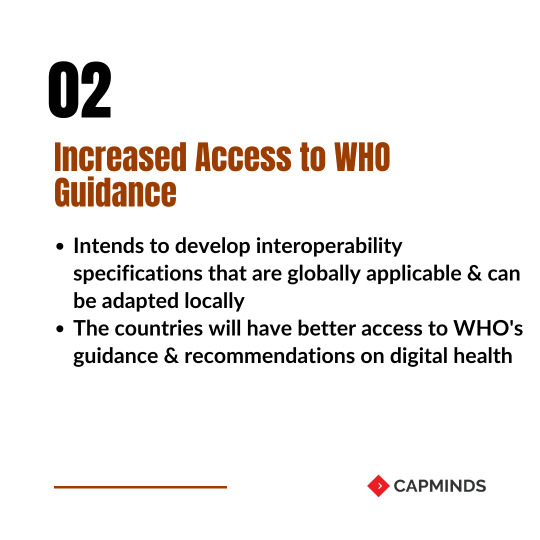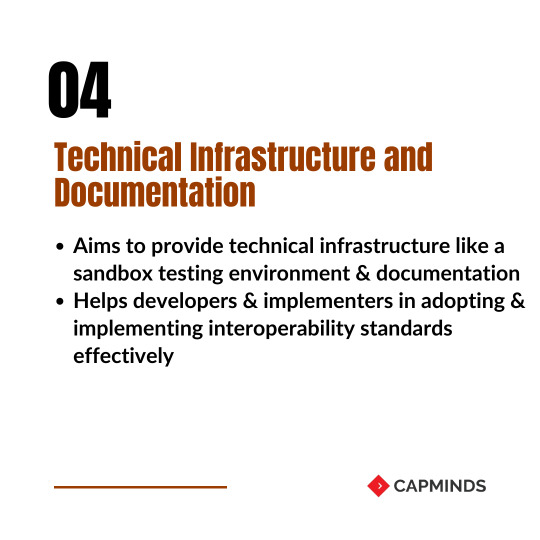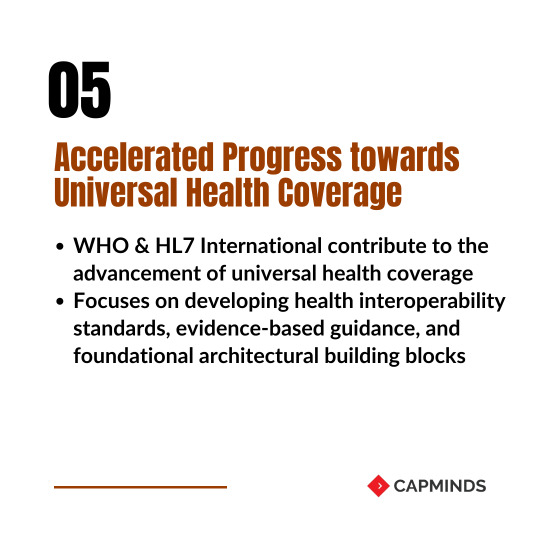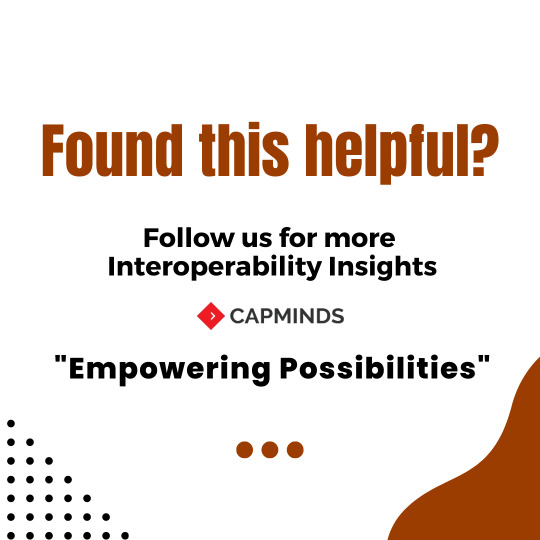#Healthcare Interoperability
Link
Fast Healthcare Interoperability Resources, or FHIR, are a crucial component of contemporary healthcare. It is a protocol for electronically transmitting medical data. It is intended to make it simpler for patients to access their health information as well as for healthcare providers to transfer data among systems. Modern web technologies are the foundation of FHIR, which was designed to be adaptable, modular, and extendable. As a result, it is an effective tool for handling healthcare data. Electronic health records (EHRs) are becoming more prevalent, and there is a growing need for efficient and secure data sharing. In reality, it's crucial to comprehending how to begin using FHIR. We will discuss the fundamentals of FHIR in this FHIR implementation guide. Provide step-by-step instructions for using this cutting-edge technology as well.
#smile cdr#FHIR#FHIR Implementation#Implement FHIR#FHIR Implementation Guide#Fast Healthcare Interoperability Resources#healthcare information exchange#Healthcare IT#Healthcare Technology#Healthcare Interoperability#HAPI FHIR#Firely FHIR#Microsoft Azure API for FHIR#Google Cloud Healthcare API#AWS HealthLake#non-technical to implement FHIR#FHIR applications#Healthcare Integration#Healthcare IT Integration#FHIR client#exchange patient data#electronic health record#EHR system#cloud platform#healthcare ecosystem#FHIR server#FHIR for healthcare
2 notes
·
View notes
Text
25 Ways Healthcare Data is Revolutionizing the Healthcare Industry
An exhaustive list for healthcare and healthcareIT colleagues and friends. Happy Reading!
Healthcare data refers to the information collected from various sources in the healthcare system, including medical records, laboratory results, and insurance claims. This data can be used in numerous ways to advance healthcare and improve patient outcomes. From improving patient safety to developing personalized treatment plans, healthcare data is a valuable tool that can help healthcare…

View On WordPress
#big data in healthcare#electronic health records#health data privacy#health data security#health information technology#healthcare AI#Healthcare Analytics#healthcare blockchain#healthcare data#healthcare data ethics#healthcare data governance#healthcare data integration#healthcare data mining#healthcare data storage#healthcare data visualization#healthcare data warehousing#Healthcare Interoperability#healthcare machine learning#medical informatics#patient outcomes#personalized medicine#Population Health Management#predictive analytics in healthcare#telemedicine#wearables in healthcare
1 note
·
View note
Text
Interoperability in healthcare refers to the ability of two or more information systems, software programmes, or devices to smoothly integrate, share, and utilise medical data. In summary, healthcare interoperability enables various medical software systems at hospitals and healthcare organisations to share data and collaborate.
#healthcare interoperability#interoperability software#EHR interoperability solutions#healthcare interoperability solutions#Healthcare Interoperabilitity Solutions
0 notes
Text
Remote Patient Monitoring App Development – Complete Guide
The next decade will witness an enormous increase in remote patient monitoring services, with a 12.5 percent annual growth rate. Given the aging population, the high expense of in-patient treatment, and the immense demand on hospitals imposed by COVID-19, the trend is entirely foreseeable.
Given the aging population, the high expense of in-patient treatment, and the immense demand on hospitals imposed by COVID-19, the trend is entirely foreseeable.
Healthcare providers are indeed adopting more remote monitoring than ever before. Several hospitals began remotely monitoring the vital signs and symptoms of both coronavirus and non-coronavirus patients to free up beds.
Remote patient monitoring is here to stay, pandemic or not. This article covers RPM in healthcare, how it works, what features it contains, remote patient monitoring benefits and how to begin an RPM program.

What is Remote Patient Monitoring?
Remote patient monitoring, also known as telemonitoring and in-home monitoring, is a combination of technologies and procedures that allow healthcare providers to follow radical improvements in a patient’s health data from a distance and use it in a treatment plan. It is an essential component of the wider telehealth and e-health industries.
The next decade will witness an exponential rise in remote patient monitoring devices, with a 12.5 percent annual growth rate. The trend is inevitable given the aging population, the high expense of in-patient treatment, and the immense demand for hospitals generated by COVID-19.
Healthcare practitioners are already employing more remote patient monitoring tools than ever before. Several hospitals began remotely monitoring the vital signs and symptoms of both coronavirus and non-coronavirus patients to free up beds.
How does Remote patient monitoring improve patient care?
Remote patient monitoring software shines a light on chronic illness patients, post-operative patients, senior citizens, and individuals from remote regions with limited access to healthcare. Recent studies show that remote monitoring can be effective when applied to specific categories.
Rehospitalizations are reduced by 38%.
Cut emergency visits by 25%.
Increase patient satisfaction by 25%.
Lower healthcare expenditures by 17%.
Increase medication compliance by 13%.
Considering the potential benefits of remote patient monitoring, it’s no wonder that over 88 percent of healthcare providers have already invested in or are planning to invest in RPM technology. To achieve their objectives, these technologies must develop an integrated system that spans the complete RPM cycle.
Authorities approved RPM practices. In the United States, the Centers for Medicare and Medicaid Services (CMS) has expanded the list of telehealth services that are eligible for reimbursement. In addition, the US Food and Drug Administration (FDA) has approved using non-invasive hospital equipment in home settings.
Features of Custom Remote patient monitoring
1. Admin Portal
A system administrator is the primary user of the software. He serves as the primary point of contact between the service provider and the service users. The system administrator can onboard users or provider groups and grant the relevant rights and permissions based on the user’s role. He can also handle and oversee all master data and associated papers.
2. User Management
This is the most crucial feature necessary for any admin position to manage all users for whom the application was designed. In this feature, administrators may create users, assign responsibilities to them, and manage all relevant settings.
3. Dashboard
The admin dashboard displays the total number of provider groups linked in the system, total providers, and patients affiliated with various provider groups. The admin may access all information and monitor every activity the provider and patient conducted using the dashboard.
4. Provider Group Management
Provider Group Management allows the administrator to manage a group of physicians. Admin will be in charge of creating, modifying, deleting, or activating/deactivating Provider groups. The admin is required to fill out specific essential fields upon registration. The following fields are included while forming a Provider group:
Provider Group Name
Email Id
Phone Number
Specialty
Physical Address
Shipping Address
Practice Fax Number
Non-Mandatory Information
Uploading a profile picture
Website
5. Patient Management
This function allows the Provider to manage Patients. It allows the Provider to onboard Patients, examine Patient profile attributes, and change Patient onboarding data. Patient management will always have the Patient’s vitals and crucial medical information with the Provider.
It will enable the Provider to follow the vitals of onboarded Patients and monitor and record appointments and notes. The Provider will be required to fill out certain obligatory areas upon registration. The following are the required data that the Provider must fill out throughout the Patient onboarding process.
Patient Name
Address
Contact information
Health conditions
6. Patient Vitals & Alerts
Remote patient monitoring is used for collecting, storing and assessing health information (patient’s vital signs, blood sugar levels, etc.) via live monitoring using devices that transfer information from the home or care facility to a practitioner for vital tracking. learn more
#remotepatientmonitoringsoftwaredevelopment#remotepatientmonitoringAppdevelopment#Remotepatientmonitoringsolutiondevelopmentcompany#Remotepatientmonitoringsoftware#Remotepatientmonitoringsolutions#Healthcare#healthcare interoperability#healthcare solutions#Healthcare Software Development Company
0 notes
Text
2 notes
·
View notes
Text
https://www.clindcast.com/
#healthcare#healthcareconsulting#florida#healthcare it consulting#healthcareit#fhir#interoperability#ehr#electronic health record
3 notes
·
View notes
Text
Navigating Healthcare Standards: A Comprehensive Guide

Welcome to our comprehensive guide on navigating healthcare standards. In today's complex healthcare landscape, understanding and adhering to healthcare regulations, ensuring compliance, achieving interoperability, maintaining quality assurance, and obtaining accreditation are essential components for success.
When it comes to healthcare regulations, staying updated is non-negotiable. From HIPAA to GDPR, healthcare providers must navigate a labyrinth of rules and guidelines to protect patient confidentiality and data security.
However, mere awareness of healthcare regulations isn't enough; organizations must actively prioritize compliance. This entails implementing robust measures to ensure adherence to legal and ethical standards, safeguarding patient information, and maintaining trust.
In today's interconnected healthcare ecosystem, interoperability is paramount. Whether it's electronic health records (EHRs) or medical devices, seamless communication between different systems and platforms enables efficient data exchange, leading to better-informed decision-making and improved patient outcomes.

Quality in healthcare isn't just a buzzword; it's a commitment to excellence. From clinical processes to administrative procedures, quality assurance permeates every aspect of patient care. By implementing rigorous quality control measures, healthcare organizations can mitigate risks, improve outcomes, and enhance patient satisfaction.
Finally, achieving accreditation signifies a dedication to meeting and exceeding industry standards. Whether pursuing Joint Commission accreditation or other recognized certifications, accreditation serves as a hallmark of quality and excellence in healthcare.
In conclusion, navigating healthcare standards demands diligence, attention to detail, and a relentless pursuit of excellence. By prioritizing healthcare regulations, ensuring compliance, embracing interoperability, maintaining quality assurance, and obtaining accreditation, healthcare organizations can position themselves for success in an increasingly competitive landscape.
Thank you for joining us on this journey through the intricacies of healthcare standards. Stay tuned for more insights and guidance to help you navigate the ever-changing world of healthcare.
1 note
·
View note
Text
Breaking Down Barriers: The Importance of Interoperability in Healthcare
In today's digital age, the adoption of Electronic Health Record (EHR) software has transformed the way healthcare providers manage patient information and deliver care. EHR solutions streamline processes, enhance communication, and improve patient outcomes. However, one critical factor that can significantly impact the effectiveness of EHR systems is interoperability. Let's explore why interoperability matters in healthcare and how it can benefit patients, providers, and the healthcare ecosystem as a whole.

What is Interoperability in Healthcare?
Interoperability refers to the ability of different healthcare systems, software, and devices to securely exchange and use patient information seamlessly. In other words, interoperability enables EHR solutions from different vendors to communicate with each other and share data efficiently, regardless of the platform or technology used.
Why Does Interoperability Matter?
Enhanced Care Coordination: Interoperability enables healthcare providers to access comprehensive patient information from various sources in real-time, facilitating seamless care coordination across different specialties, settings, and organizations. This ensures that providers have a complete picture of a patient's medical history, medications, allergies, and treatment plans, leading to more informed decision-making and better outcomes.
Improved Patient Safety: By promoting the exchange of accurate and up-to-date patient information, interoperability helps reduce the risk of errors, duplicate tests, and adverse drug events. This enhances patient safety and reduces the likelihood of medical errors that can result from incomplete or fragmented health records.
Efficient Workflow: Interoperable EHR software solutions streamline workflows by eliminating the need for manual data entry, faxing, and paper-based processes. This saves time, reduces administrative burden, and allows healthcare providers to focus more on patient care, ultimately improving efficiency and productivity.
Empowered Patients: Interoperability gives patients greater control over their health information, allowing them to access and share their medical records securely with other healthcare providers as needed. This promotes patient engagement, empowers individuals to take an active role in their healthcare decisions, and fosters collaboration between patients and providers.
Interoperability Standards: To achieve seamless data exchange, interoperability standards such as HL7 (Health Level Seven) and FHIR (Fast Healthcare Interoperability Resources) play a crucial role. These standards establish common formats, protocols, and vocabularies for exchanging health information, ensuring compatibility and consistency across different systems.
Interoperability and Population Health Management: Interoperable EHR solutions facilitate population health management initiatives by aggregating and analyzing data from diverse sources. This enables healthcare organizations to identify trends, track outcomes, and implement targeted interventions to improve the health of entire patient populations.
Conclusion
In an increasingly interconnected healthcare landscape, interoperability is essential for optimizing patient care, improving clinical outcomes, and driving innovation. By breaking down data silos and enabling seamless information exchange, interoperable EHR software solutions empower healthcare providers to deliver more coordinated, efficient, and patient-centered care.
At Meditab, we recognize the critical role that interoperability plays in advancing healthcare delivery. Our comprehensive EHR solution is designed to promote interoperability, enabling seamless data exchange and collaboration across the healthcare continuum. To learn more about our interoperable EHR software solution and how it can benefit your practice, visit our website here or contact us today.
Together, let's embrace interoperability and harness the power of connected health to transform the future of healthcare delivery.
#ehr software#ehr solutions#ehr software companies#ehr integration#interoperability#interoperability healthcare
0 notes
Text
Demystifying Hybrid Cloud: A Comprehensive Guide to Cloud Computing
In the ever-evolving landscape of technology, cloud computing has emerged as a cornerstone of innovation, enabling organizations to streamline operations, enhance scalability, and drive digital transformation. Within the realm of cloud computing, one concept that has gained significant traction is the hybrid cloud model. In this article, we will delve into the intricacies of hybrid cloud, exploring its definition, benefits, challenges, and real-world applications.

Understanding Hybrid Cloud
At its core, hybrid cloud refers to a computing environment that combines elements of public and private clouds, allowing organizations to leverage the strengths of both platforms. In a hybrid cloud setup, specific workloads, applications, or data are seamlessly orchestrated between on-premises infrastructure and public cloud services, such as Amazon Web Services (AWS), Microsoft Azure, or Google Cloud Platform (GCP).
The hybrid cloud model offers unparalleled flexibility, enabling organizations to optimize resource allocation, meet fluctuating demand, and maintain control over sensitive data and critical workloads. By seamlessly integrating private and public cloud environments, businesses can achieve a dynamic and scalable infrastructure that adapts to their evolving needs.
Benefits of Hybrid Cloud
One of the primary advantages of hybrid cloud is its ability to strike a balance between the scalability and cost-effectiveness of public clouds and the security and customization of private clouds. By leveraging a hybrid cloud strategy, organizations can:
Scalability: Hybrid cloud allows businesses to scale their infrastructure seamlessly, leveraging the elastic resources of public clouds during peak demand while maintaining dedicated resources for sensitive workloads.
Cost Optimization: With hybrid cloud, organizations can optimize costs by allocating workloads to the most cost-effective cloud environment based on performance requirements, compliance regulations, and budget constraints.
Data Security and Compliance: Hybrid cloud enables organizations to retain sensitive data on-premises or in a private cloud environment while leveraging the agility and scalability of public clouds for less sensitive workloads. This approach ensures compliance with industry regulations and data protection standards.
Disaster Recovery and Business Continuity: By replicating data and workloads across multiple cloud environments, hybrid cloud enhances resilience and enables efficient disaster recovery and business continuity strategies, minimizing downtime and data loss.
Flexibility and Agility: Hybrid cloud provides organizations with the flexibility to deploy workloads where they best fit, whether on-premises, in a private cloud, or in the public cloud. This agility allows businesses to respond quickly to changing market dynamics and customer demands.
Challenges of Hybrid Cloud
While hybrid cloud offers numerous benefits, it also presents challenges that organizations must address to maximize its potential. Some of the key challenges include:
Complexity: Managing workloads across multiple cloud environments introduces complexity in terms of networking, security, and governance. Organizations need robust management tools and skilled personnel to navigate the complexities of hybrid cloud deployments effectively.
Data Integration and Interoperability: Ensuring seamless data integration and interoperability between on-premises infrastructure and public cloud services can be challenging. Organizations must implement robust data management strategies and integration solutions to facilitate smooth data exchange across environments.
Security and Compliance: Hybrid cloud environments introduce security risks associated with data movement between on-premises and public cloud environments. Organizations must implement stringent security measures, encryption protocols, and access controls to mitigate security threats and ensure compliance with regulatory requirements.
Vendor Lock-In: Depending heavily on a single cloud provider can lead to vendor lock-in, limiting flexibility and hindering migration between cloud environments. Organizations must adopt a multi-cloud strategy and embrace interoperable technologies to avoid vendor lock-in and maintain flexibility.
Cost Management: While hybrid cloud offers cost optimization opportunities, effectively managing costs across multiple cloud environments can be challenging. Organizations must closely monitor resource utilization, optimize workload placement, and leverage cost management tools to control expenses and avoid cost overruns.
Real-World Applications
Hybrid cloud is increasingly being adopted across various industries and use cases, driven by its flexibility, scalability, and cost-effectiveness. Some common real-world applications of hybrid cloud include:
Enterprise IT: Large enterprises often leverage hybrid cloud to modernize legacy IT infrastructure, optimize resource utilization, and facilitate digital transformation initiatives while maintaining control over critical workloads and sensitive data.
E-commerce and Retail: Retailers utilize hybrid cloud to handle seasonal spikes in demand, enhance customer experiences, and streamline e-commerce operations. By leveraging public cloud scalability for web applications and on-premises infrastructure for backend systems, retailers can ensure optimal performance and reliability.
Healthcare: Healthcare organizations leverage hybrid cloud to securely store and analyze sensitive patient data, comply with healthcare regulations such as HIPAA, and enhance collaboration among healthcare professionals. Hybrid cloud enables healthcare providers to deploy healthcare applications and services flexibly while ensuring data privacy and security.
Finance and Banking: Financial institutions utilize hybrid cloud to enhance agility, scalability, and security while complying with stringent regulatory requirements. Hybrid cloud enables banks and financial services firms to modernize legacy systems, deploy innovative fintech solutions, and drive digital innovation while safeguarding customer data and ensuring regulatory compliance.
Manufacturing and Industry 4.0: Manufacturers leverage hybrid cloud to optimize production processes, enhance supply chain visibility, and drive operational efficiency. By combining on-premises infrastructure with cloud-based analytics and IoT platforms, manufacturers can gain real-time insights, improve decision-making, and accelerate innovation in the era of Industry 4.0.
In conclusion, hybrid cloud represents a powerful paradigm shift in cloud computing, offering organizations the flexibility, scalability, and agility to meet the demands of today's digital economy. While hybrid cloud presents challenges, its benefits outweigh the complexities, driving widespread adoption across industries and use cases. By embracing hybrid cloud, organizations can unlock new opportunities for innovation, growth, and competitive advantage in an increasingly interconnected and dynamic world.
#Hybrid cloud#Cloud computing#Public cloud#Private cloud#Scalability#Cost optimization#Data security#Compliance#Disaster recovery#Business continuity#Flexibility#Agility#Complexity#Data integration#Interoperability#Security#Vendor lock-in#Cost management#Real-world applications#Enterprise IT#E-commerce#Retail#Healthcare#Finance#Banking#Manufacturing#Industry 4.0.
0 notes
Text
Medical Practices Need to Embrace Two-Way Texting and AI

Let's face it, calling your doctor's office can be an exercise in frustration. Long hold times, automated menus, and the dreaded elevator music...it's enough to make anyone lose their cool. But what if there was a better way?
Here's the truth: traditional voice-only medical practices are outdated. Patients shouldn't have to waste precious time on hold for simple tasks like scheduling appointments, refilling prescriptions, or paying bills. This outdated system creates a frustrating experience for everyone involved. Patients are left feeling unheard and unimportant, while overwhelmed front desk staff struggle to keep up with the constant ringing.
There's a better way. Medical practices can leverage technology to offer a more convenient and efficient experience for patients. Here's how:
Embrace two-way texting: Texting is the dominant communication method today. Studies show a 95% open rate for text messages, meaning patients are far more likely to see and respond to a text than answer a call. Two-way texting allows for real-time conversations, streamlining communication for both patients and staff. Practices can leverage this technology to:
Schedule appointments
Refill prescriptions
Send directions to the office location
Answer basic questions
Send appointment reminders and confirmations
Collect patient feedback
The good news? You don't have to ditch your existing phone number! Text-enabling technology allows you to seamlessly integrate texting with your current office phone line. This means patients can still reach you at the familiar number they know, but with the added convenience of texting.
Smarter texting with AI: Instead of a clunky AI chatbot, a smarter texting solution powered by AI can assist both staff and patients. This AI assistant can:
Understand natural language: No more robotic responses! The AI can understand the intent behind a patient's text message, allowing for a more natural and efficient conversation.
Provide automated responses: The AI can handle frequently asked questions and basic tasks like appointment confirmations, prescription refill reminders, and insurance updates.
Route complexities to staff: For more complex inquiries, the AI can seamlessly route the conversation to a staff member, ensuring all patient needs are met.
But it doesn't stop there. Here's what a winning texting solution should offer:
EHR integration: A seamless integration with your Electronic Health Record (EHR) ensures all patient information is readily available for a smooth texting experience.
Worklist management: An easy-to-use interface allows front office staff to manage their workload efficiently, prioritize messages, and collaborate with the AI assistant for faster responses.
By implementing these technologies, medical practices can:
Reduce hold times: No more waiting on hold! Patients can handle routine tasks quickly and efficiently.
Improve patient satisfaction: A more convenient experience leads to happier patients.
Increase staff efficiency: Freeing up staff from constant phone calls allows them to focus on more complex tasks and patient care.
The time for change is now. Let's ditch the outdated phone-only system and embrace a more patient-centric approach. Two-way texting with the help of an AI assistant offers a future where medical care is convenient, efficient, and puts the patient first.
Ready to transform your patients' experience? Contact us for more information.
0 notes
Text
Why is Interoperability Important in Healthcare?
Interoperability in healthcare isn't just a buzzword – it's a game-changer! Imagine seamlessly sharing your medical records between different healthcare providers, ensuring that crucial information is always at your fingertips, regardless of where you seek care.
Interoperability fosters better coordination and communication among healthcare professionals, leading to more accurate diagnoses, personalized treatment plans, and improved patient outcomes. Plus, it streamlines administrative tasks, reducing inefficiencies and saving valuable time and resources.
Ultimately, interoperability enhances patient safety, empowers informed decision-making, and promotes a holistic approach to healthcare delivery. Let's embrace interoperability and pave the way for a healthier, more connected future!
0 notes
Link
Integrating Health Information Exchange (HIE) is an effective strategy to streamline clinical workflows and improve patient outcomes. By engaging a managed service provider, the necessary resources can be procured to establish a secure HIE network. HIE involves multiple stakeholders and is a highly complex process; however, it is essential to find ways to securely exchange data between all participants.
Discover the types, and benefits of Health Information Exchange and how HIE technology integration helps in overcoming healthcare industry challenges
#types of health information exchange#health data exchange#Health Information Exchange#Healthcare Information Exchange#Healthcare Integration#Healthcare Interoperability#HIE#HIE Healthcare#Information Exchange#redox ehr integration#Healthcare#healthcare software development#healthcare app development
2 notes
·
View notes
Text
2024: The Dawn of Interconnected Healthcare

Envision a world where medical records seamlessly traverse between hospitals, medical practices, and pharmacies, guiding care decisions. Healthcare's future shines bright in 2024, illuminated by three major trends poised to revolutionize how we experience and deliver health: interoperability, revenue cycle management (RCM) optimization, and empowered patient engagement.
Interoperability
The longstanding aspiration of unlocking healthcare data is finally becoming a reality. After years of anticipation, 2023 witnessed the momentous launch of the nationwide data exchange powered by TEFCA (Trusted Exchange Framework and Common Agreement). This landmark framework acts as a key, unlocking data silos and allowing medical records to flow freely across different healthcare systems nationwide. This unprecedented data liberation promises to harmonize care coordination, drastically reducing medical errors and eliminating redundant tests. The future of healthcare looks brighter than ever, with patients empowered to actively participate in their own journey by easily accessing their complete medical picture across disparate providers.
RCM Evolution
Picture cloud-based RCM platforms powered by AI automation, where bills are personalized, claims processed seamlessly, and denials tackled proactively. We are well on the path to realizing this vision. According to a recent survey conducted by Change Healthcare, 98% of healthcare leaders across the US plan to leverage AI across their revenue cycle within the next three years. This aligns with several other studies from organizations like HFMA and NBER, all highlighting the rising adoption of AI for tasks like automated claims processing, personalized billing, and proactive denial management. This growing focus on AI-powered RCM is fueled by its potential to support value-based care models, where providers are rewarded for improved patient outcomes rather than just the number of procedures performed.
Patient Engagement, Redefined
With virtual care models taking center stage, AI advances like Google’s PaLM2 and others are fueling a patient-centric healthcare revolution. Robust language models tailor interventions, while intelligent assistants handle appointments and provide real-time support. The healthcare landscape is transitioning from hospital to the comfort of our homes, empowered by convenient virtual consultations and remote monitoring.
Beyond the Horizon
This glimpse into the healthcare landscape of 2024 is just the first act. Picture wearable sensors feeding real-time health data into AI-powered models that predict and prevent illnesses. The possibilities are limitless, driven by ongoing technological advancements and an unwavering commitment to patient-centered care.
So, buckle up. We stand on the precipice of a transformative era where data intertwines with innovation, finances align with outcomes, and patients rightfully take center stage in their well-being. The future of healthcare is not merely interconnected – it's genuinely human-centric, and 2024 is only the beginning.
Ready to make this journey easier? Reach out to Falkondata and discover how we can streamline your process and achieve your goals.
#ehr#future of healthcare#health and wellness#AdvancedMD#Falkondata#interoperability#EHR Integration#FHIR#health tech#patient care#medical billing services#healthcare industry#hl7
0 notes
Text
Fhir Interoperability UK
Join the data exchange revolution with FHIR interoperability. Seamlessly connect systems, streamline workflows, and revolutionize care coordination.
0 notes
Text
EMR software development
Has it been long since you’ve seen a doctor writing you down a paper note? It’s because electronic notes are now widely used in medical facilities. Organizations and healthcare providers often use electronic medical records (EMRs) to maintain vital information about your health and well-being. This guide will explain What EMR is, its benefits and how to develop custom EMR software development.

What is EMR?
EMR is a digital version of a patient’s medical record. An EMR software system allows healthcare facilities to create, store and receive these records.
EMRs contain personal information about the patient, including:
Demographic Information
Vitals
Comment
Drug Information
Lab test results
Immunization records
Allergy Information
In addition to storing and organizing patient medical information, EMR can also be used to:
EMRs do more than just store and organize patient data.
Allow patients to access their medical records via an online patient portal.
Assist providers in prescribing medication.
Used to request lab test results.
Medical bill integration with built-in encryption and billing software.
Difference between EHR and EMR?
The significant difference between EMRs and EHRs is that EHRs are administered by numerous providers, whereas EMRs are solely managed by one. This implies that an EHR has more data than an EMR. Providers primarily use EMRs for diagnosis and treatment.
Another contrast is that EHRs are supposed to be interoperable, but EMRs are not. Interoperability refers to multiple systems’ capability to interchange and uses data among themselves. This is significant because it gives providers access to a patient’s complete medical record, even if they visit many providers. EHRs allow patients’ medical data to be sent locally and globally to specialists, laboratories, imaging facilities, emergency departments and pharmacies.
Key features of Custom EHR/EMR Software
1. Easy Patient Onboarding
Providers can connect with their patients by enrolling them and collecting information such as demographics, contact information, insurance information, clinical data and prior medical and family history. This will result in a strong relationship between the patient and the practitioner.
2. Appointment Scheduling
Providers can effortlessly book appointments with patients and email the patient the customized evaluation form and questionnaire for self-check-in and assessment.
3. Patient Charting- Clinical and E-Prescription
A one-of-a-kind portal that allows patients to view their medical records. It also includes reports from past visits and treatment. Electronic prescribing allows providers to provide digital prescriptions. This feature’s development in electronic medical records software is crucial. This tool allows doctors to notify other team members about medication allergies and other issues.
4. Patient Education
Some health IT providers use natural language processing to translate clinical terminology for individuals with low health literacy, making patient portal records more accessible.
When applicable, patient education is the most effective strategy to enhance consumer health literacy. As more health IT suppliers establish license deals with educational platforms, they will be able to integrate patient education resources into their systems.
5. Reminders, Notifications & Alerts
When a patient schedules an appointment with a healthcare professional, the system can respond through e-mail, text message (SMS) or push notification to a mobile device. Furthermore, users might be reminded to take prescription medicine or check their glucose levels if they have diabetes. Learn more
#EMR systems#EMR software#electronic medical records software#medical record software#healthcare interoperability#Healthcare#healthcare solutions
0 notes
Text







The collaboration between WHO and HL7 International brings together their respective expertise and resources to drive the adoption and appropriate use of interoperability standards globally.
This collaboration has the potential to harmonize digital health systems, improve data exchange and continuity of care, and contribute to the overall goal of achieving universal health coverage.
2 notes
·
View notes